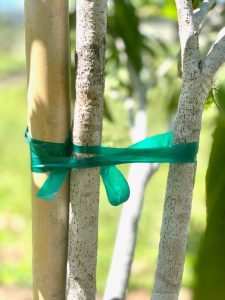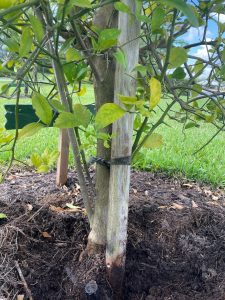Rainy season is almost here, and it’s a great time start planting tropical fruit trees. The consistent rain can help minimize the transplant shock that new trees experience and you may even be able to use less water to get your tree established, as long as the rain/irrigation applied is fairly consistent for those critical first few weeks. Once the tree is properly planted, it’s important to follow water and fertilization recommendations.
Many times we get contacted about unthrifty tropical fruit trees in backyards. While there can be multiple reasons why your trees are not thriving, one issue we see is folks not taking nursery stakes off their trees after planting. Sometimes, it looks like the stakes have been bound to the tree for years.

Trees come tied with wooden or bamboo stakes from the nursery. The purpose of this practice is to help the tree grow straight, provide support while the tree’s roots are growing in a contained area (the pot), and create a more uniform vertical growing area to save on space. It can also help with uprooting and falling over during winds while the tree is establishing it’s root system.

Once the tree is planted in the ground, you should take your stakes off in a timely manner. For small fruit trees, within 2-6 weeks of planting and for large trees no more than 3-6 months after planting. Florida’s weather and climate provide for almost year-round growth for tropical fruit trees and their root system is constantly putting out feeder and structural roots to make the tree stable and able to access nutrients. The sooner you remove the stakes, the faster the tree will develop reaction wood, which enhances its stability. It’s similar to how using your arm builds strength, whereas keeping it in a splint leads to atrophy from lack of use.
View this post on Instagram
If stakes and tape are left on for too long, the tree becomes stunted and unthrifty and you will slowly strangle your tree. When stakes stay tightly bound to the outer and inner bark, they cut into the tree layer called the cambium layer, which is the growing park of the trunk, and can stunt growth over the long term, as seen in the photo below.

Keep an eye on your tree and if it starts to lean or you have a wind event that causes it to tip over, you can always stake it again temporarily. But ensure the stakes are not tightly bound to the trunk of the tree.
When done properly, staking provides stability so the tree can support itself and assist in establishing a strong root system. However, if staking is done poorly or for too long, it can do more harm than good.
 6
6
